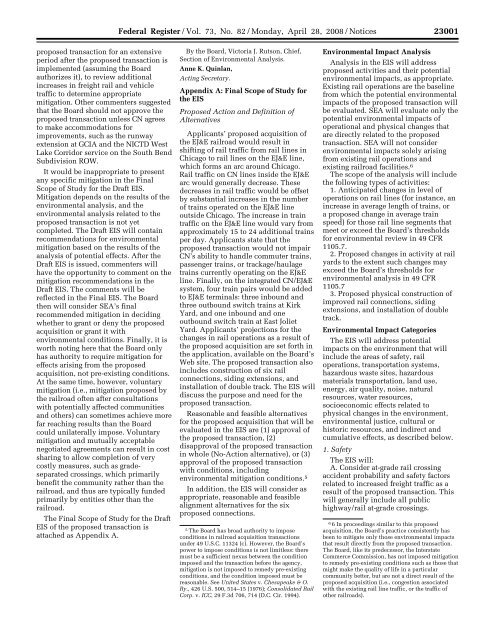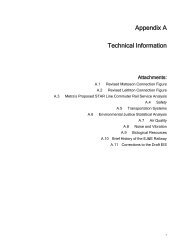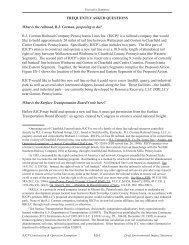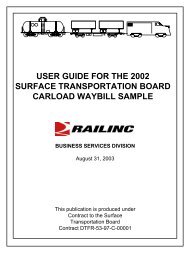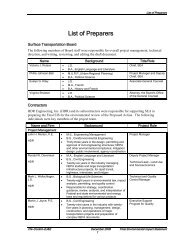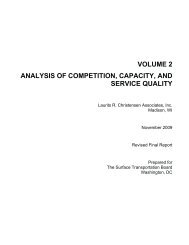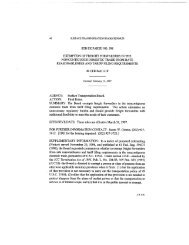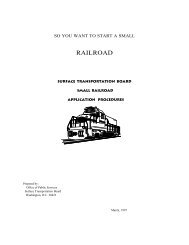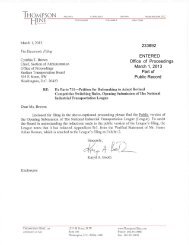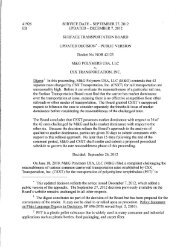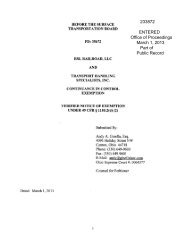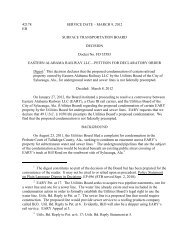Attachments - Surface Transportation Board - U.S. Department of ...
Attachments - Surface Transportation Board - U.S. Department of ...
Attachments - Surface Transportation Board - U.S. Department of ...
You also want an ePaper? Increase the reach of your titles
YUMPU automatically turns print PDFs into web optimized ePapers that Google loves.
Federal Register / Vol. 73, No. 82 / Monday, April 28, 2008 / Notices<br />
23001<br />
pwalker on PROD1PC71 with NOTICES<br />
proposed transaction for an extensive<br />
period after the proposed transaction is<br />
implemented (assuming the <strong>Board</strong><br />
authorizes it), to review additional<br />
increases in freight rail and vehicle<br />
traffic to determine appropriate<br />
mitigation. Other commenters suggested<br />
that the <strong>Board</strong> should not approve the<br />
proposed transaction unless CN agrees<br />
to make accommodations for<br />
improvements, such as the runway<br />
extension at GCIA and the NICTD West<br />
Lake Corridor service on the South Bend<br />
Subdivision ROW.<br />
It would be inappropriate to present<br />
any specific mitigation in the Final<br />
Scope <strong>of</strong> Study for the Draft EIS.<br />
Mitigation depends on the results <strong>of</strong> the<br />
environmental analysis, and the<br />
environmental analysis related to the<br />
proposed transaction is not yet<br />
completed. The Draft EIS will contain<br />
recommendations for environmental<br />
mitigation based on the results <strong>of</strong> the<br />
analysis <strong>of</strong> potential effects. After the<br />
Draft EIS is issued, commenters will<br />
have the opportunity to comment on the<br />
mitigation recommendations in the<br />
Draft EIS. The comments will be<br />
reflected in the Final EIS. The <strong>Board</strong><br />
then will consider SEA’s final<br />
recommended mitigation in deciding<br />
whether to grant or deny the proposed<br />
acquisition or grant it with<br />
environmental conditions. Finally, it is<br />
worth noting here that the <strong>Board</strong> only<br />
has authority to require mitigation for<br />
effects arising from the proposed<br />
acquisition, not pre-existing conditions.<br />
At the same time, however, voluntary<br />
mitigation (i.e., mitigation proposed by<br />
the railroad <strong>of</strong>ten after consultations<br />
with potentially affected communities<br />
and others) can sometimes achieve more<br />
far reaching results than the <strong>Board</strong><br />
could unilaterally impose. Voluntary<br />
mitigation and mutually acceptable<br />
negotiated agreements can result in cost<br />
sharing to allow completion <strong>of</strong> very<br />
costly measures, such as gradeseparated<br />
crossings, which primarily<br />
benefit the community rather than the<br />
railroad, and thus are typically funded<br />
primarily by entities other than the<br />
railroad.<br />
The Final Scope <strong>of</strong> Study for the Draft<br />
EIS <strong>of</strong> the proposed transaction is<br />
attached as Appendix A.<br />
By the <strong>Board</strong>, Victoria J. Rutson, Chief,<br />
Section <strong>of</strong> Environmental Analysis.<br />
Anne K. Quinlan,<br />
Acting Secretary.<br />
Appendix A: Final Scope <strong>of</strong> Study for<br />
the EIS<br />
Proposed Action and Definition <strong>of</strong><br />
Alternatives<br />
Applicants’ proposed acquisition <strong>of</strong><br />
the EJ&E railroad would result in<br />
shifting <strong>of</strong> rail traffic from rail lines in<br />
Chicago to rail lines on the EJ&E line,<br />
which forms an arc around Chicago.<br />
Rail traffic on CN lines inside the EJ&E<br />
arc would generally decrease. These<br />
decreases in rail traffic would be <strong>of</strong>fset<br />
by substantial increases in the number<br />
<strong>of</strong> trains operated on the EJ&E line<br />
outside Chicago. The increase in train<br />
traffic on the EJ&E line would vary from<br />
approximately 15 to 24 additional trains<br />
per day. Applicants state that the<br />
proposed transaction would not impair<br />
CN’s ability to handle commuter trains,<br />
passenger trains, or trackage/haulage<br />
trains currently operating on the EJ&E<br />
line. Finally, on the integrated CN/EJ&E<br />
system, four train pairs would be added<br />
to EJ&E terminals: three inbound and<br />
three outbound switch trains at Kirk<br />
Yard, and one inbound and one<br />
outbound switch train at East Joliet<br />
Yard. Applicants’ projections for the<br />
changes in rail operations as a result <strong>of</strong><br />
the proposed acquisition are set forth in<br />
the application, available on the <strong>Board</strong>’s<br />
Web site. The proposed transaction also<br />
includes construction <strong>of</strong> six rail<br />
connections, siding extensions, and<br />
installation <strong>of</strong> double track. The EIS will<br />
discuss the purpose and need for the<br />
proposed transaction.<br />
Reasonable and feasible alternatives<br />
for the proposed acquisition that will be<br />
evaluated in the EIS are (1) approval <strong>of</strong><br />
the proposed transaction, (2)<br />
disapproval <strong>of</strong> the proposed transaction<br />
in whole (No-Action alternative), or (3)<br />
approval <strong>of</strong> the proposed transaction<br />
with conditions, including<br />
environmental mitigation conditions. 5<br />
In addition, the EIS will consider as<br />
appropriate, reasonable and feasible<br />
alignment alternatives for the six<br />
proposed connections.<br />
5 The <strong>Board</strong> has broad authority to impose<br />
conditions in railroad acquisition transactions<br />
under 49 U.S.C. 11324 (c). However, the <strong>Board</strong>’s<br />
power to impose conditions is not limitless: there<br />
must be a sufficient nexus between the condition<br />
imposed and the transaction before the agency,<br />
mitigation is not imposed to remedy pre-existing<br />
conditions, and the condition imposed must be<br />
reasonable. See United States v. Chesapeake & O.<br />
Ry., 426 U.S. 500, 514–15 (1976); Consolidated Rail<br />
Corp. v. ICC, 29 F.3d 706, 714 (D.C. Cir. 1994).<br />
VerDate Aug2005 18:22 Apr 25, 2008 Jkt 214001 PO 00000 Frm 00084 Fmt 4703 Sfmt 4703 E:\FR\FM\28APN1.SGM 28APN1<br />
Environmental Impact Analysis<br />
Analysis in the EIS will address<br />
proposed activities and their potential<br />
environmental impacts, as appropriate.<br />
Existing rail operations are the baseline<br />
from which the potential environmental<br />
impacts <strong>of</strong> the proposed transaction will<br />
be evaluated. SEA will evaluate only the<br />
potential environmental impacts <strong>of</strong><br />
operational and physical changes that<br />
are directly related to the proposed<br />
transaction. SEA will not consider<br />
environmental impacts solely arising<br />
from existing rail operations and<br />
existing railroad facilities. 6<br />
The scope <strong>of</strong> the analysis will include<br />
the following types <strong>of</strong> activities:<br />
1. Anticipated changes in level <strong>of</strong><br />
operations on rail lines (for instance, an<br />
increase in average length <strong>of</strong> trains, or<br />
a proposed change in average train<br />
speed) for those rail line segments that<br />
meet or exceed the <strong>Board</strong>’s thresholds<br />
for environmental review in 49 CFR<br />
1105.7.<br />
2. Proposed changes in activity at rail<br />
yards to the extent such changes may<br />
exceed the <strong>Board</strong>’s thresholds for<br />
environmental analysis in 49 CFR<br />
1105.7<br />
3. Proposed physical construction <strong>of</strong><br />
improved rail connections, siding<br />
extensions, and installation <strong>of</strong> double<br />
track.<br />
Environmental Impact Categories<br />
The EIS will address potential<br />
impacts on the environment that will<br />
include the areas <strong>of</strong> safety, rail<br />
operations, transportation systems,<br />
hazardous waste sites, hazardous<br />
materials transportation, land use,<br />
energy, air quality, noise, natural<br />
resources, water resources,<br />
socioeconomic effects related to<br />
physical changes in the environment,<br />
environmental justice, cultural or<br />
historic resources, and indirect and<br />
cumulative effects, as described below.<br />
1. Safety<br />
The EIS will:<br />
A. Consider at-grade rail crossing<br />
accident probability and safety factors<br />
related to increased freight traffic as a<br />
result <strong>of</strong> the proposed transaction. This<br />
will generally include all public<br />
highway/rail at-grade crossings.<br />
6 6 In proceedings similar to this proposed<br />
acquisition, the <strong>Board</strong>’s practice consistently has<br />
been to mitigate only those environmental impacts<br />
that result directly from the proposed transaction.<br />
The <strong>Board</strong>, like its predecessor, the Interstate<br />
Commerce Commission, has not imposed mitigation<br />
to remedy pre-existing conditions such as those that<br />
might make the quality <strong>of</strong> life in a particular<br />
community better, but are not a direct result <strong>of</strong> the<br />
proposed acquisition (i.e., congestion associated<br />
with the existing rail line traffic, or the traffic <strong>of</strong><br />
other railroads).


